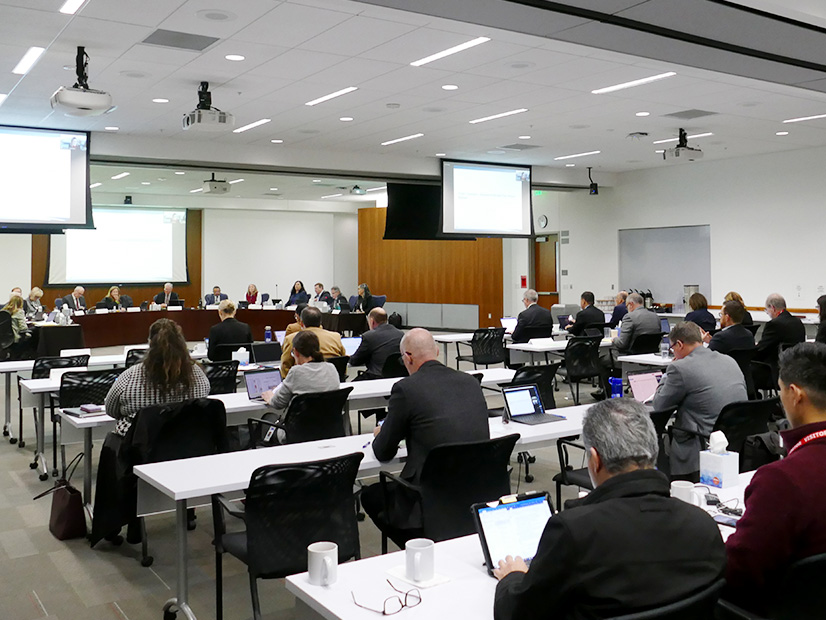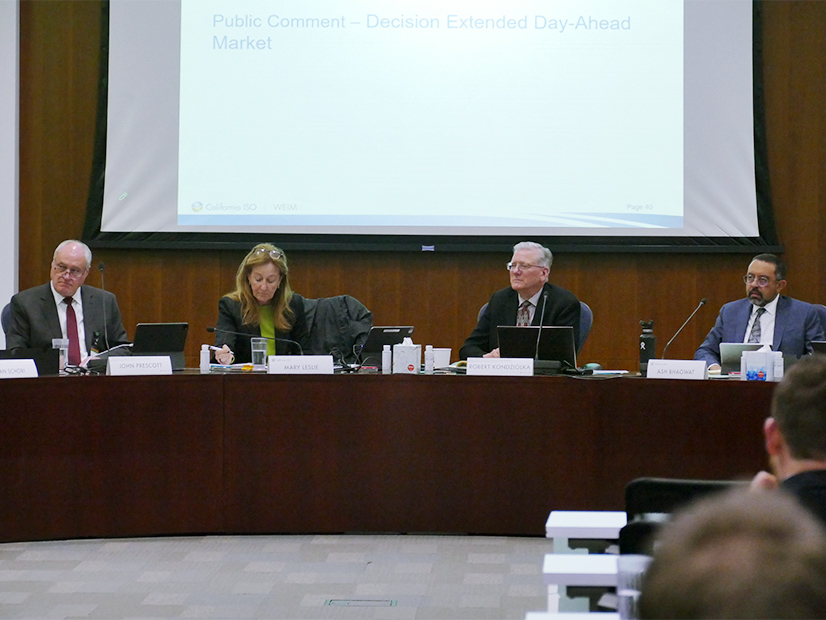
FOLSOM, Calif. — The CAISO Board of Governors and the Western Energy Imbalance Market Governing Body on Wednesday approved a plan to incorporate a day-ahead market into the Western EIM, calling it a milestone in regional grid integration.
“Today holds the promise for a new West, an opportunity for a new beginning in expanded markets and increased regional coordination,” WEIM Governing Body Chair Robert Kondziolka said in opening remarks. “The decision items at today’s meeting, if approved, are groundbreaking and profound.”
 From left: WEIM Governing Body member John Precott, CAISO Board of Governors Chair Mary Leslie, WEIM Governing Body Chair Robert Kondziolka, and CAISO Governor Ashutosh Bhagwat listened to public comments on EDAM. | © RTO Insider LLC
From left: WEIM Governing Body member John Precott, CAISO Board of Governors Chair Mary Leslie, WEIM Governing Body Chair Robert Kondziolka, and CAISO Governor Ashutosh Bhagwat listened to public comments on EDAM. | © RTO Insider LLC
The extended day-ahead market (EDAM) proposal passed with unanimous votes from both governing bodies, which met in-person together for the first time since the pandemic began three years ago to exercise their joint authority over the WEIM.
After years of planning and stakeholder meetings, the EDAM promises to greatly expand the amount of electricity traded in the sprawling WEIM, which will cover nearly 80% of load in the Western Interconnection once three new members join this year. The market now deals only with real-time transactions, yet it has generated $3.4 billion in benefits for its members since it went live in late 2014.
Real-time trades are only a small part of the electricity market. Day-ahead transactions represent a far larger share. Transactions in both timeframes limit curtailment of renewable resources, such as California’s abundant midday solar power, and allow for purchases of less expensive electricity during times of tight supply.
A study prepared for CAISO by Energy Strategies found that the EDAM could generate $1.2 billion a year in benefits, or 60% of the savings of a West-wide RTO, if it encompassed the entire U.S. portion of the Western Interconnection.
The West, with its 39 balancing authorities in states divided by geographic and political differences, is pursuing several major regionalization efforts, any of which could eventually establish the first Western RTO. In addition to EDAM, the Western Power Pool is awaiting FERC approval to launch its Western Resource Adequacy Program, and SPP is planning its own day-ahead market and a Western version of its Eastern RTO.
CAISO must also win FERC approval for the EDAM, which it hopes to start operating in 2024 or 2025.
‘Important New Step’
PacifiCorp, a founding member of the WEIM, became the first entity to commit to join the EDAM in December. Others are expected to follow. The WEIM now has 19 members in all Western states, except for Colorado, and stretches from the Mexican border into British Columbia.
Key provisions of the EDAM design include a resource sufficiency evaluation intended to ensure participants can meet their internal demand for electricity before engaging in the day-ahead market — a means of preventing members from “leaning” on the market for supply. The final EDAM plan includes a tiered structure of financial penalties for failing to meet the test.
“The day-ahead RSE evaluates, across the next day 24-hour horizon, whether each balancing area’s supply offered into the day-ahead market is sufficient to meet its next day forecasted load, imbalance reserve obligation, and self-provisioned ancillary service obligations,” a CAISO staff memo to the boards said. “This includes functionality to allow each balancing authority to evaluate on an advisory basis its progress toward meeting the final RSE so they may take steps to cure any anticipated insufficiencies prior to the execution of the day-ahead market.”
It also includes a provision that market participants make their internal transmission available for EDAM transfers.
“The availability of transmission, both internal to the system and across interfaces between balancing areas in EDAM, is foundational to optimizing unit commitment in the day-ahead market and to identifying robust energy transfers across the EDAM footprint,” the memo says.
Balancing authorities in the EDAM will retain control of their resource and transmission planning.
A separate decision on EDAM governance approved a plan developed by the WEIM’s Governance Review Committee that adopts the WEIM’s joint authority model for the EDAM while broadening the scope of that authority as well as the WEIM Governing Body’s solo authority over certain matters.
The governance plan was developed during many hours of stakeholder meetings and was broadly supported.
A third decision related to the WEIM and EDAM refined the ISO’s controversial wheel-through limits, which it enacted in 2021 as a temporary measure to promote in-state reliability during summer heat waves. A number of out-of-state WEIM members opposed the limits. (See FERC OKs CAISO Wheel-through Restrictions.)
Under its new plan, the ISO will calculate available transfer capability (ATC) to determine how much it needs and how much it can make available to others.
“In calculating the ATC, the ISO would set aside transmission capacity for forecasted or estimated native load needs, including load growth, and establish a transmission reliability margin (TRM) to account for different elements of uncertainty,” a staff memo said. “Management further proposes a process through which wheel through customers can request and access limited ATC that may be available on the intertie. The process requires them to demonstrate they have a firm power supply contract to serve external load or a contract conditioned on their ability to obtain ATC.”
Some stakeholders continued to take issue with the plan, saying it undermines open-access transmission principles, the memo noted. CAISO staff said the “proposed design provides a reasonable bridge between the Open Access Transmission Tariff (OATT) framework and the current ISO market structure.”
Regarding EDAM, stakeholder comments were broadly supportive, though some came with caveats about details to be worked out later.
Stakeholder comments were broadly supportive, though some came with caveats about details to be worked out later.
A coalition of 26 entities from across the West — including major utilities, environmental groups and trade organizations — expressed written support for the plan while acknowledging there is more to do.
“The undersigned entities support Board and Governing Body approval of the EDAM Final Proposal,” the joint letter said. “To be sure, all the work is not yet done, and some entities will still need to conduct their own assessments of whether and when they might expect to join the EDAM, and seek regulatory approvals if applicable.
“There will be significant implementation and market mechanics to be worked through, and the potential EDAM entities will also have to reflect the new market in their own Open Access Transmission Tariffs under which they provide service to their transmission customers,” it said. “But the basics on governance, resource sufficiency, transmission access and revenue attribution, and greenhouse gas rules enable the start of an important new step in regional market evolution.”
